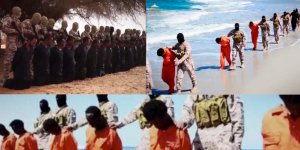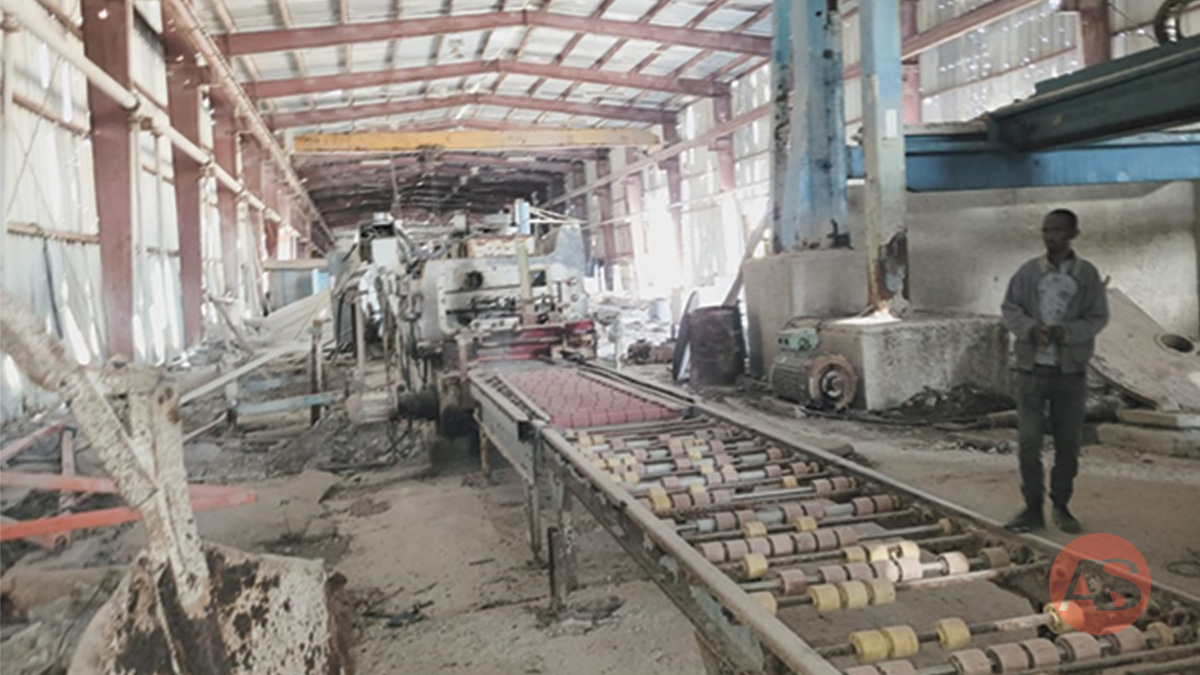In-depth Analysis -As Libya finds bodies of Ethiopians executed by ISIS, the film director of that horrific video is alive and remains at large. What we know
Zecharias Zelalem, For Addis Standard
Addis Abeba, December 24/2018 – Yesterday Reuters reported that “the bodies of 34 Ethiopian Christians executed in Libya by Islamic State (IS) in 2015 have been exhumed from a mass grave.” Reuters cited Libyan authorities as the source of the news, the kind of news that sends chills through the hearts of millions of Ethiopians at home and abroad.
This is the story of what we know about the man believed to be responsible for the videotaping of at least one section of the horrific video depicting the brutal executions of up to 28 Ethiopian and Eritrean Christians (as was reported at the time) in Libya. He is still alive but at large. Abdul Qader Al-Najdi, an Iraqi national said to still be serving as a high-ranking commander of the Libyan branch of the so called Islamic State of Iraq and Syria (ISIS), is believed to have dictated part of the gory production’s proceedings from behind the camera. The video, published to YouTube before being quickly removed for user violations in April 2015, devastated Ethiopians who promptly took to the streets of cities across the country to denounce the atrocity. Three days of national mourning were declared by the Ethiopian government as a result.
 ISIS parades its fighters in the streets of Sirte sometime in early 2015. The group has since been pushed out of Sirte and all major population centers it used to govern as part of its “caliphate” (image: ISIS)
ISIS parades its fighters in the streets of Sirte sometime in early 2015. The group has since been pushed out of Sirte and all major population centers it used to govern as part of its “caliphate” (image: ISIS)
According to a UN report released in July of this year, there are an estimated 3000-4000 ISIS militants in Libya under Al-Najdi’s command. The report states that despite claims that he had been killed in an air strike, he is still very much alive and actively leading the group. Although the threat posed by the militants has been greatly reduced, they are still capable of carrying out attacks against the battered Libyan establishment. Last month, an attack by ISIS militants on a police station in a town located in the central Libyan district of Jufra left five people dead.
Director of execution videos
Al-Najdi’s role in the production of two ISIS execution videos came to light years after they were first released. Unlike other ISIS commanders who enjoy the limelight and the infamy that comes with it, Al-Najdi is something of a recluse. Despite his reported expertise with videography, he has refused to even be photographed for propaganda purposes. This has perhaps aided him in evading capture or death, as a recent UN report citing Libyan government sources states that he remains the group’s acting head in the country.
Al-Najdi, who is also known by the alias Abu Muaz Al-Tikriti, was reportedly dispatched to Libya by the ISIS central leadership of Abu Bakr Al-Baghdadi sometime in late 2014. He reportedly helped coordinate the group’s propaganda as well as its transitioning from a militia to an entity exercising control over cities like Derna. At its peak in early 2015, the Islamist group controlled entire towns and swathes of the Libyan desert, profiting from the power vacuum and anarchy caused by the fallout amongst the former comrades in arms who were supposed to jointly lead the post Gaddafi era Libyan government. In recent years, ISIS in Libya has suffered setbacks and no longer enjoys authority over entire towns. Successive defeats to rivals and the Libyan population’s general opposition to the group’s methods have seen the militants retreat into the desert and abandon conventional warfare for a guerrilla style insurgency. In March 2016, while ISIS militants were being routed from their former strongholds and airstrikes from Libya’s coalition partners were depleting their ranks, Al-Najdi was announced as the emir or supreme commander of the remaining ISIS contingent in Libya.
 Screenshot from video depicting the beheading of 20 Egyptian Copts and a Ghanaian migrant in Sirte
Screenshot from video depicting the beheading of 20 Egyptian Copts and a Ghanaian migrant in Sirte
Al-Najdi’s role in the dissemination of graphic execution videos wasn’t known until late 2017. In February 2015, ISIS militants released their first of such horrific videos appearing to show the beheading of 20 Egyptian Coptic Christians and a Ghanaian migrant. Cooperation between Egyptian and Libyan authorities resulted in a number of the militants involved in the murders of the Egyptians being arrested last year. One of the detained ISIS militants, a Palestinian named Hisham Al-Awlaky, confessed to being among those who beheaded the Copts. He revealed that at the execution site in the coastal town of Sirte, Al-Najdi ran the show, giving orders to masked militants to frogmarch their orange jumpsuit clad victims along the beach to the spot they would be decapitated. He instructed a fluently English speaking lead militant to point his knife at the camera and threaten the west. Al-Awlaky revealed that when one of the Egyptian victims, realizing he was about to be murdered on camera attempted to fight off his captors, Al-Najdi halted the recording and ordered the hostage to be beaten until he stopped resisting. He then proceeded with the grisly killings that plunged Egypt into a period of mourning. Al-Najdi was something of a perfectionist, telling militants how to march and how to position their hostages. He told all the executioners to place the severed heads of their victims on the backs of their dismembered bodies after the killings were complete.
 Hisham Al-Awlaky was among the masked killers who murdered the group of Egyptian hostages. He confessed to his role in the massacre and revealed that Al-Najdi also employed Egyptians, Tunisians and Senegalese members of ISIS to star as executioners in his video. He has been sentenced to death by a Libyan court (Image: Libya anti-crime Department)
Hisham Al-Awlaky was among the masked killers who murdered the group of Egyptian hostages. He confessed to his role in the massacre and revealed that Al-Najdi also employed Egyptians, Tunisians and Senegalese members of ISIS to star as executioners in his video. He has been sentenced to death by a Libyan court (Image: Libya anti-crime Department)
In April 2015, Al-Najdi’s second video release showing the murders of Ethiopian and Eritrean Orthodox Christians featured the same fluently English speaking masked individual as the lead killer. The video featured two clips spliced together into one. One clip appeared to show twelve men in bright orange jumpsuits being beheaded along the beaches of the Mediterranean, while 16 others in black jumpsuits are shown being shot in the back of the head with automatic weapons. The English speaking lead who was seen in the February video release delivering a message before personally beheading Ghanaian migrant Matthew Ayariga, was again featured as speaker before gunning down Addis Abeba native Eyassu Yikunoamlak with a pistol.
This lead militant was initially believed to be a westerner or a Libyan expat due to his North American sounding English. But militants and officials identified him as being Saudi national Abu Amer Al-Jazrawi. Not much is known about Al-Jazrawi either but his accent suggests he may have spent a part of his youth in either Europe or North America, probably as a student which is relatively common among Saudis. His fluent English speaking abilities are likely what earned him a starring role in both execution videos. His efforts at recruiting fighters weren’t limited to his appearances in the two macabre videos, he is believed to have been an active Tweeter, using the now suspended Twitter handle @Jazrawi_Oooud (link to archived tweets) to call on Muslims to join the ranks of ISIS militants in either Syria, Iraq or Libya. In early 2016, as Libyan government forces closed in on the then ISIS controlled city of Sirte, Al-Jazrawi played a key role in preparing ISIS defenses for the government assault. In the end, ISIS forces were wiped out as the government recaptured Sirte. Al Jazrawi was killed in March of 2016 by Libyan government forces. The government announced that the bodies of 700 ISIS militants killed in and around Sirte, including that of Al-Jazrawi, remained in the freezers of a morgue, unclaimed. Addis Standard has contacted the Saudi embassy in an attempt to get information on the identity of the lead killer to no avail.
 Saudi national Abu Amer Al-Jazrawi (center) points the his weapon at the camera during his tirade against Christians. He would later use it to execute the Ethiopian hostage kneeling in front of him, Eyassu Yikunoamlak. In 2016, Libyan forces killed Al-Jazrawi in a shootout
Saudi national Abu Amer Al-Jazrawi (center) points the his weapon at the camera during his tirade against Christians. He would later use it to execute the Ethiopian hostage kneeling in front of him, Eyassu Yikunoamlak. In 2016, Libyan forces killed Al-Jazrawi in a shootout
In an interview with Addis Standard, Italian journalist Daniele Raineri, an expert on Libya based Islamist groups stated that he was “100% certain” that Abdul Qader Al-Najdi was the man who directed both videos. “The massacre of the Egyptian Copts, and the video of the Ethiopians, the man responsible for both videos is Abdul Qader,” he said.
“All the local wilayats (provinces) would record videos and send the footage to Syria for editing. The leadership in Syria are the ones who decide what the final product looks like.”
Raineri explained how the decision to merge the two clips may have been one made by a central production house in Syria.
“With the Ethiopians, you had two clips. Since the victims were of a common religion, I think the ISIS leadership decided to put the clips into the same video with the theme of fighting Christianity. Sometimes they sit on videos for months before they decide how to present them to the world.”
 Screenshots from the horrific video show the first group of victims in black jumpsuits as they are about to be shot and the second group of victims being marched prior to their beheading
Screenshots from the horrific video show the first group of victims in black jumpsuits as they are about to be shot and the second group of victims being marched prior to their beheading
Both videos feature Christian hostages being marched in orange jumpsuits along the beaches of the Mediterranean by masked killers. The camera angles, locations and use of the same starring lead in Al-Jazrawi do suggest a high likelihood that both videos were directed by the same individual. While some ISIS productions, such as the beheading of westerners James Foley and Steven Sotloff in Syria omit the actual killing, Al-Najdi’s clearly relishes the gore. Both of his videos feature close up footage of beheading and the Mediterranean sea water being tainted by blood.
Unlike the Egyptian government, which has gone to great lengths to investigate the barbaric killings of its citizens and prosecute those responsible, the Ethiopian government until very recently had never publicly expressed any interest in gaining such closure. In May of this year, the Egyptian and Libyan governments repatriated the remains of the 21 victims killed in the February 2015 video release after recovering the bodies. A number of the killers have been sentenced to death for their roles in that mass killing.
The bodies of the Ethiopians and Eritreans killed in Al-Najdi’s second video production however, are yet to be recovered. Prime Minister Abiy Ahmed, elected in April of this year finally announced that he had brought up the issue with Egyptian President Abdel Fattah Al-Sisi during his June state visit to Cairo. Al-Sisi reportedly promised to assist in a search for the remains of the killed Ethiopians and Eritreans. The Eritrean government meanwhile, has never issued any sort of statement acknowledging its citizens were among those in the videotaped slayings. The memories of the video release three years ago remain very fresh in the collective Ethiopian/Eritrean psyche as do the trauma and emotions of the day.
The Libyan central government’s frailties and its continuous fighting with opposing factions and other Islamist groups have affected its ability to inflict a killer blow against ISIS. Ousted in Syria and Iraq, they remain pocketed in areas between the Jufrah and Southern Sirte districts, according to the above mentioned UN report. Despite currently fairing better than his comrades in Libya and Syria, Abdul Qader Al-Najdi’s days of capturing gruesome killings in high definition from multiple angles are likely gone forever. A marked man, he remains sought after by the American military’s drone program and a host of hostile armed rival entities jostling for control of the Libyan countryside. AS








